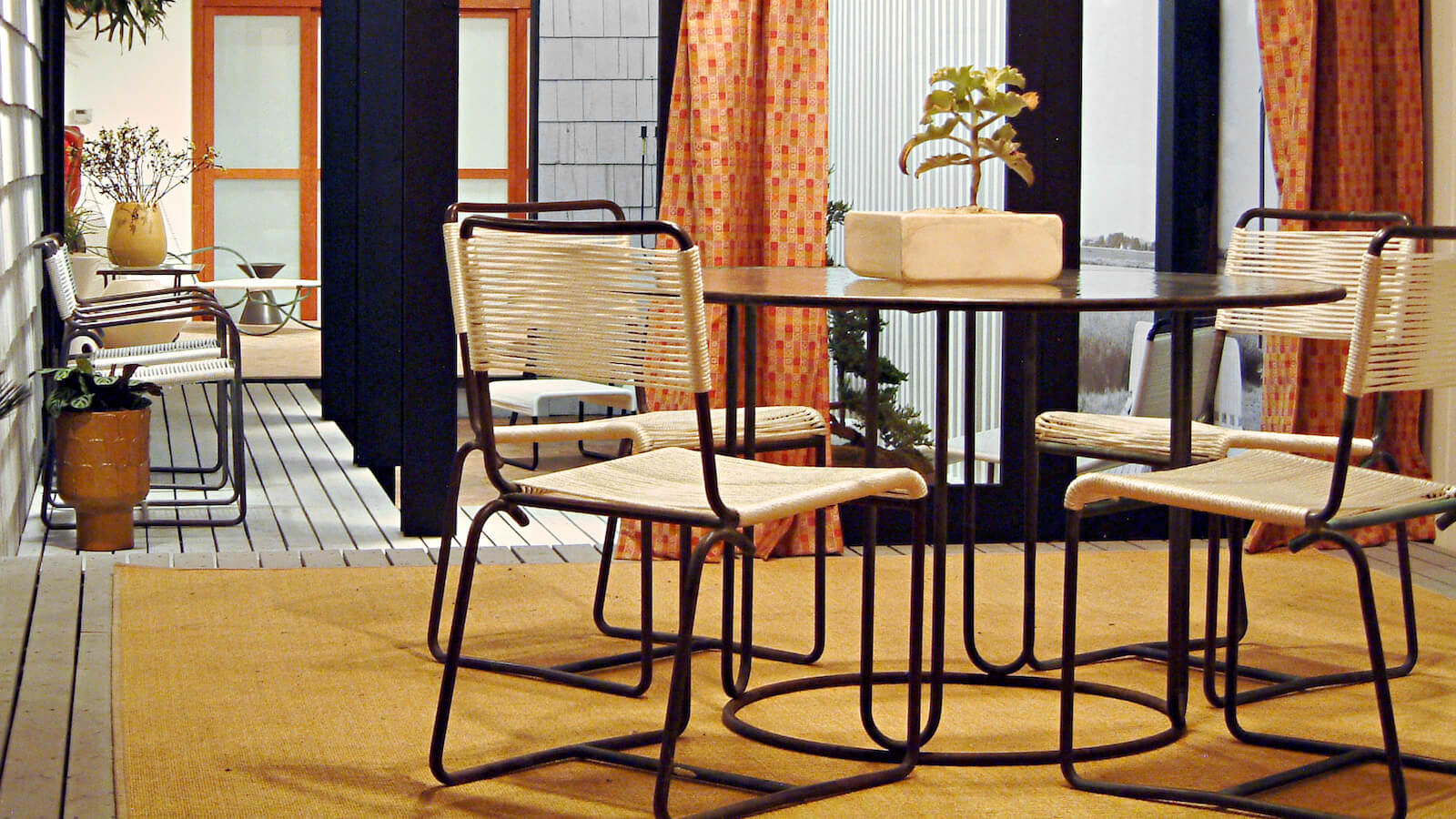Outside
26 April - 1 August 2002
82 Franklin St NY 10013
R 20th Century in collaboration with Steven Learner Studio presents ‘Outside,’ an exhibition opening on April 25th, 2002. Incorporating the aesthetics of the rooftop terrace, the beach house, and even the window box garden, ‘Outside’ features designs to inspire anyone who wants more of the outdoors in their lives.
This is the first show of R Gallery’s 2002 season, following their successful exhibition on Danish designer Verner Panton. The Gallery has received several reviews in the New York Times lauding them for their groundbreaking work creating a space in which to experience and learn about great design from the mid 20th century.
Steven Learner Studio is a Manhattan based architectural design firm that specializes in art related spaces, both residential and commercial. In addition to numerous residences in Manhattan and the Hamptons incorporating mid-century and period furnishings, they recently completed the Sean Kelly Gallery in Chelsea. Working with R Gallery, Steven Learner Studio has utilized the essential elements of the modernist house to re-create the continuity of interior and exterior space emblematic of this style.
Exhibition
R and Steven Learner Studio worked together to transform the entire R Gallery into an idyllic garden environment inspired by the mid-century beach houses of the Hamptons. The show features an impressive collection of vintage outdoor furnishings from such renowned American designers as Hendrick van Keppel and Taylor Green as well as the rare and elegant work of Walter Lamb. Also to be featured for the first time in New York is a major collection of Architectural Pottery including designs from La Gardo Tackett, Rex Goode, John Follis, Paul McCobb, and Malcolm Leland.
The R Gallery once again has taken the idea of a design exhibition to a new level. The comprehensive installation encourages the viewer to take part in the once-revered lifestyle of leisure, comfort and style. The use of native pines, sea grass and cactus encapsulate the idea of “indoor outdoor living” where the walls are brought down by the use of floor to ceiling glass and the plants become a design element equal to that of a sculpture. The use of stone, glass, wood and steel take you off of the New York street above and into a lush summer garden of Good Design.
Architectural Pottery
Los Angeles 1947, the birthplace of Architectural Pottery, was an exciting time for architecture and design. With the Case Study program introduced to the world by John Entenza’s magazine Arts and Architecture, Architectural Pottery immediately began appearing in almost every photo spread. The planters were used both as functional objects and as sculptural elements, and primarily as a means of bringing the outdoors in and incorporating plants into the living environment while complementing the surrounding architecture. Made in Los Angeles between the late 1940’s until the end of the1960’s the small company Architectural Pottery served the architects of the area and even made it across the country to the summer homes of Connecticut and the Hamptons.
The ceramic planters are executed in diverse shapes that vary from the largest biomorphic ceramic tubs to more geometric inverted cones, to simple and elegant cylindrical containers of many sizes. They were fired at an extremely high temperature and were porous enough to allow for moisture evaporation without drainage so that a plant could thrive indoors or out without damaging the surface below the planter. They came in unglazed white as well as a range of colored glazes, with options of cork and redwood bases to elevate the planter.
In a unique marriage of good design and horticulture, the huge collection of original Architectural Pottery planters in the ‘Outside’ exhibition will be planted according to their size and maintained throughout the show. New York based garden editor and designer Lindsey Taylor will select the plants and design the extensive gardens within the space. Both the planters and the plants will be available for purchase.
Outdoor Furnishings
The group of outdoor furnishings collected by R Gallery features designs by well known mid-century names as well as excellent rare and unique pieces from unknown designers of the period.
The iconic work of New York based designer Alan Gould fits perfectly with pieces by the Los Angeles based design duo of Hendrick Van Keppel and Taylor Green. These two formed the company Van Keppel Green and produced the chaise lounge that has become emblematic of the leisure associated with an outdoor lifestyle. They also coordinated interiors for the successful Case Study House program in Los Angeles, and their furniture was widely used across the country. A common denominator in Julius Shulman’s famous outdoor shots from the 1950’s their lounge chair and ottoman, made of tubular steel and yacht cord, articulates a balance of simplicity and elegance that makes it perfect for any patio with room to stretch out.
Another luminary represented in ‘Outside’ is Walter Lamb. Lamb got his start in Hawaii designing furniture made out of parts salvaged from ships sunk in Pearl Harbor. His wildly successful line for Brown Jordan united the elegance of bronze with the informality of string and cord, creating a product for patios that was distributed nationwide. Lamb’s work is a paragon of simplicity and quality in outdoor furnishings.
‘Outside’
Following in the tradition of their previous exhibitions, ‘Outside’ adds several more names to the roster of important mid 20th century designers. This show once again changes the way we look at and think about mid-century design and its importance as a fixture of American culture. The collaboration between Steven Learner Studio and R 20th Century unites two of the most forward thinking firms in architecture and design in a show that is challenging, educational and inspirational.
